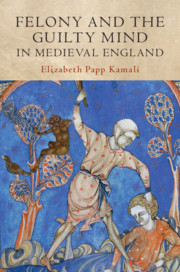(Source: CUP)
Cambridge University Press has published a new
book on the role of mens rea during the first two centuries of the English
criminal trial jury.
ABOUT THE BOOK
This book
explores the role of mens rea, broadly defined as a factor in jury assessments
of guilt and innocence from the early thirteenth through the fourteenth century
- the first two centuries of the English criminal trial jury. Drawing upon
evidence from the plea rolls, but also relying heavily upon non-legal textual
sources such as popular literature and guides for confessors, Elizabeth Papp
Kamali argues that issues of mind were central to jurors' determinations of
whether a particular defendant should be convicted, pardoned, or acquitted
outright. Demonstrating that the word 'felony' itself connoted a guilty state
of mind, she explores the interplay between social conceptions of guilt and
innocence and jury behavior. Furthermore, she reveals a medieval understanding
of felony that involved, in its paradigmatic form, three essential elements: an
act that was reasoned, was willed in a way not constrained by necessity, and
was evil or wicked in its essence.
ABOUT THE AUTHOR
Elizabeth Papp Kamali, Harvard Law School, Massachusetts
Elizabeth Papp Kamali is Assistant Professor of Law at Harvard Law School, Massachusetts.
Elizabeth Papp Kamali is Assistant Professor of Law at Harvard Law School, Massachusetts.
TABLE OF
CONTENTS
List of figures
Acknowledgments
List of abbreviations
Introduction
The history of Mens Rea
Methodology
The trial jury and its predecessors: Anglo-Saxon and Angevin Antecedents
A brief chapter summary
The essentials of medieval English felony procedure
Part I. Felonia Felonice Facta: Felony and Intentionality:
1. The meaning of felony
1.1 Felonia Felonice Facta and the question of non-felonious felonies
1.2 The etymology of felony
2. Felony in the archives
2.1 Words of felony in law and literature
2.2 Accomplice liability and the nexus between actus reus and mens rea
2.3. A felonious state of mind
2.4 Conclusion to Part I
Part II. Þe Deuylys Doghtyr of Hellë Fyre: Felony and Emotion:
3. The language of anger
3.1 An elite emotional episode: the Warenne-Zouche Incident
3.2 The history of law and emotion
3.3 The language of anger
3.4 Anger and the common law: an overview
3.5 Passion in the plea rolls
3.6 Melancholic felony in Gower's Tale of Canace and Machaire
4. Cultural understandings of anger
4.1 Anger and the judgment day
4.2 Positive manifestations of the passion
4.3 Anger in the confessional
4.4. Slights, affronts, and provocations
4.5 Anger, provocation, and the medieval English jury
4.6 Conclusion to Part II
Part III. Handlyng Synne: Guilt and Innocence:
5. Confession and circumstantial inquiry
5.1 Confessions of a horse thief
5.2 A confessing society
5.3 Inquiry into the circumstances
5.4 The role of confession in felony adjudication
6. Guilt assessment in medieval England
6.1 Handlyng Synne and crime
6.2 Sins of thought, speech, deed
6.3 Rankings of sins and crimes
6.4 Conclusion to Part III
Part IV. Dies Iræ: Judge and Jury:
7. Tales of judging
7.1 The perils and prosaic nature of judging
7.2 Pontius Pilate and deference to jury verdicts
7.3 The misjudging of Christ and its resonance
8. The mind and comportment of judge and jury
8.1 Erkenwald and the Pagan judge
8.2 Harsh justice tempered by mercy
8.3 The proper comportment of those who judge
8.4 Judicial states of mind
8.5 Conclusion to Part IV
Conclusion
Looking back
Looking forward
Legal literacy and the medieval English jury
Bibliography
Index.
Acknowledgments
List of abbreviations
Introduction
The history of Mens Rea
Methodology
The trial jury and its predecessors: Anglo-Saxon and Angevin Antecedents
A brief chapter summary
The essentials of medieval English felony procedure
Part I. Felonia Felonice Facta: Felony and Intentionality:
1. The meaning of felony
1.1 Felonia Felonice Facta and the question of non-felonious felonies
1.2 The etymology of felony
2. Felony in the archives
2.1 Words of felony in law and literature
2.2 Accomplice liability and the nexus between actus reus and mens rea
2.3. A felonious state of mind
2.4 Conclusion to Part I
Part II. Þe Deuylys Doghtyr of Hellë Fyre: Felony and Emotion:
3. The language of anger
3.1 An elite emotional episode: the Warenne-Zouche Incident
3.2 The history of law and emotion
3.3 The language of anger
3.4 Anger and the common law: an overview
3.5 Passion in the plea rolls
3.6 Melancholic felony in Gower's Tale of Canace and Machaire
4. Cultural understandings of anger
4.1 Anger and the judgment day
4.2 Positive manifestations of the passion
4.3 Anger in the confessional
4.4. Slights, affronts, and provocations
4.5 Anger, provocation, and the medieval English jury
4.6 Conclusion to Part II
Part III. Handlyng Synne: Guilt and Innocence:
5. Confession and circumstantial inquiry
5.1 Confessions of a horse thief
5.2 A confessing society
5.3 Inquiry into the circumstances
5.4 The role of confession in felony adjudication
6. Guilt assessment in medieval England
6.1 Handlyng Synne and crime
6.2 Sins of thought, speech, deed
6.3 Rankings of sins and crimes
6.4 Conclusion to Part III
Part IV. Dies Iræ: Judge and Jury:
7. Tales of judging
7.1 The perils and prosaic nature of judging
7.2 Pontius Pilate and deference to jury verdicts
7.3 The misjudging of Christ and its resonance
8. The mind and comportment of judge and jury
8.1 Erkenwald and the Pagan judge
8.2 Harsh justice tempered by mercy
8.3 The proper comportment of those who judge
8.4 Judicial states of mind
8.5 Conclusion to Part IV
Conclusion
Looking back
Looking forward
Legal literacy and the medieval English jury
Bibliography
Index.
More information here


No comments:
Post a Comment